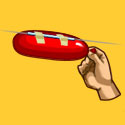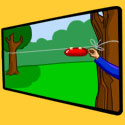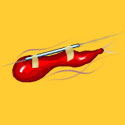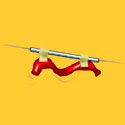
Contributed By: www.jason.org
Share This Experiment




Experiment Category:
Objective:
Investigate how force and thrust work to propel rockets into outer space.
What You Need:
- Drinking Straw
- Fishing line or string (long enough to reach from one end of a room to the other)
- Long balloon
- Transparent tape
- Twist tie
To Do and Observe:
1) Blow up your balloon. Seal the opening with a removable twist tie.2) Tape a drinking straw lengthwise along one side of the balloon. Thread the string through the straw.3) Attach one end of the string to a post or door handle.4) Pull the line taut and attach the other end to an object across the room (or have a friend hold the end of the string).5) Once the setup is complete, untie the twist tie and release your balloon.6) Repeat the experiment, but re-string your string on an incline (tie the other end to a taller object, or have your friend hold it up higher). Release the balloon at the lower end.
What's Going On:
Your balloon follows Newton's Third Law of Motion: Every action produces an equal and opposite reaction. When the air rushes out the back of your balloon, it pushes the balloon in the opposite direction. Your balloon rocket moves quite easily horizontally, but doesn't move as easily in a vertical direction. It needs more thrust to gain the necessary speed to overcome gravity. Scientists would be unable to send probes (like Voyager, Magellan, and Galileo) into space without basic knowledge of the laws of physics. Certain forces and speeds are needed to break away from Earth's gravity. For a rocket to break away from the Earth's gravitational pull, it must travel at 11.2 km per second, or 25,000 miles per hour! For this reason, the probe must be launched with the help of a rocket. Rocket fuel consists of liquid hydrogen and oxygen. When the fuel is burned, the gases escape downward, thrusting the rocket upward.
Parent/Teacher Tips:
Repeat the experiment using different amounts of air in the balloon. See how far the balloon can travel on the string with different amounts of air. Make a set up using 2 balloon rockets that face in opposite directions on the same string track. Tape a 2-foot piece of string between the two inflated balloons. Launch them simultaneously. As the balloons fight to break free of each other, ask your children to explain why the pair moves one way or the other, or simply stands still.
